MG Comet EV Car: Price, Features and Specification
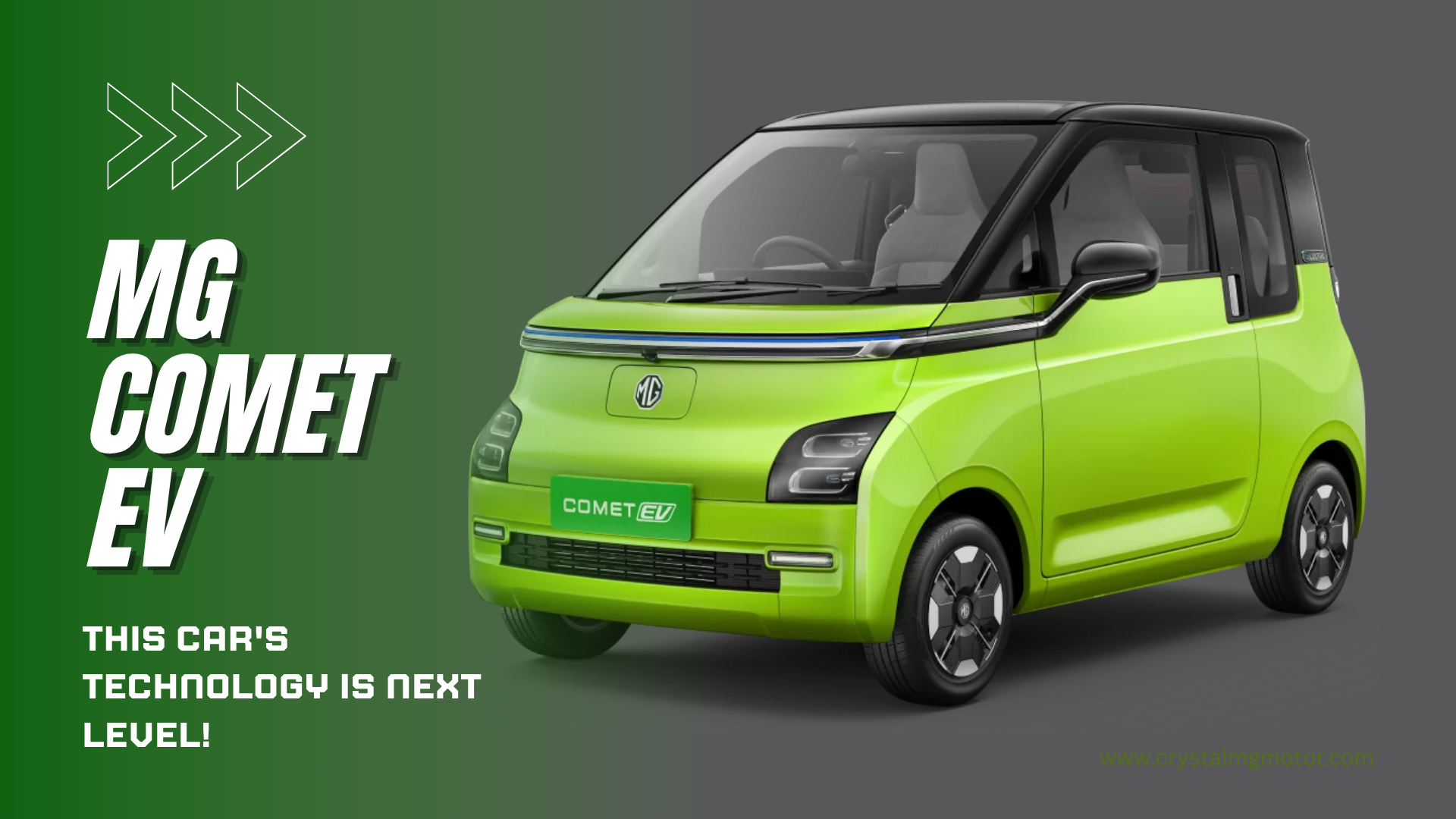
The MG Comet EV Car is a new compact electric car launched in India in 2025. It is a very small two-door, four-seater hatchback designed mainly for city driving. Despite its tiny size, MG emphasizes a premium feel: the car has quirky, modern styling with LED headlamps and taillamps, a sleek “pillarless” look (flush-mounted windows), and even connecting light bars on the front and rear. The interior uses high-quality materials and offers a twin-screen dashboard – a 10.25-inch digital instrument cluster paired with a 10.25-inch touchscreen infotainment display – plus features like a leather-wrapped steering wheel and ample storage. MG markets the Comet as a “lifestyle EV” rather than just an economy city car, a personal urban mobility solution for people who don’t want the hassle of a large vehicle in traffic.
Exterior and Interior Features
On the outside, the MG Comet EV Car stands out with its small dimensions (just 2.97 m long and 1.50 m wide, about the size of a subcompact car). It rides on 12‑inch wheels with skinny 145/70 R12 tyres, which help give it a tight turning radius of just 4.2 m – handy for maneuvering in city traffic. The design is modern and fun: MG calls attention to features like an illuminated MG logo and a front “extended horizon” light bar. Top variants (like the new Blackstorm edition) add special touches such as starry black paint and red-accent graphics for a sportier look.
Inside, the Comet EV is surprisingly spacious for its size. MG says it seats four adults (two in front and two in the rear) despite having only two doors. The cabin is bright and well-appointed: reviewers note the quality feels far above a typical cheap hatchback. The standout feature is the floating twin display – the 10.25-inch digital gauge cluster sits in line with the 10.25-inch infotainment touchscreen, all mounted together in a single panel. This setup supports wireless Android Auto and Apple CarPlay, voice controls, and MG’s i‑Smart connected-car system (with over 55 cloud-based features). Lower variants have fabric seats, while higher ones (and special editions) get leatherette trim; the Exclusive models even have four-speaker stereo and faux-leather seats for a more premium feel. Other comfort and convenience touches include keyless entry, a smart digital key, steering-wheel audio controls, an electronic parking brake, power-folding outside mirrors, and automatic climate control on upper trims. There is a small boot (around 240 litres) and a foldable rear seat, though space is naturally limited by the car’s length.
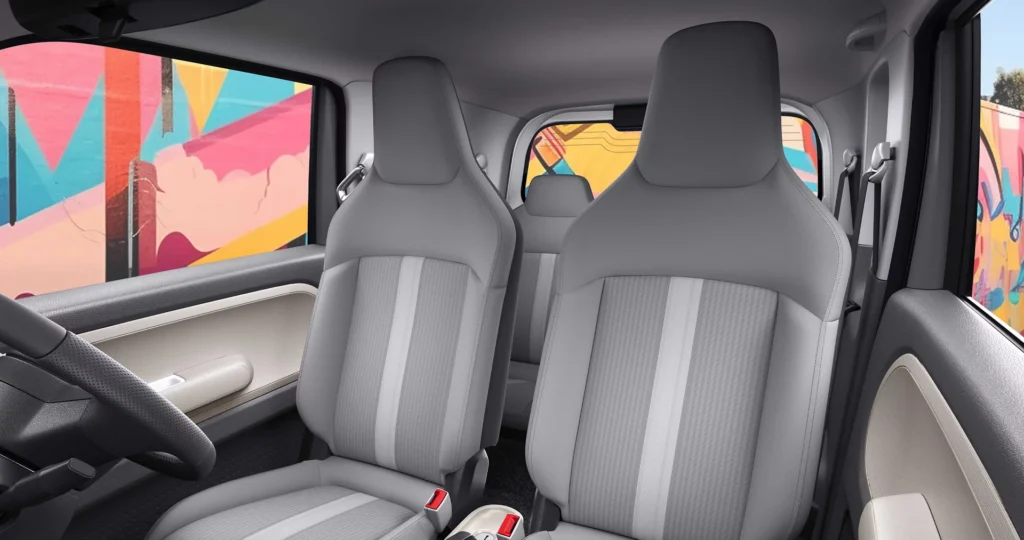
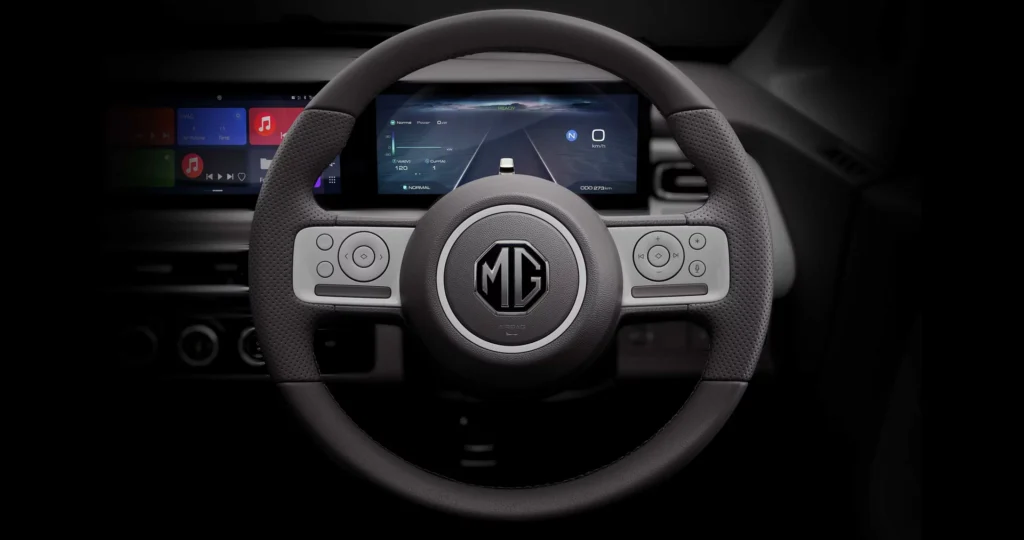
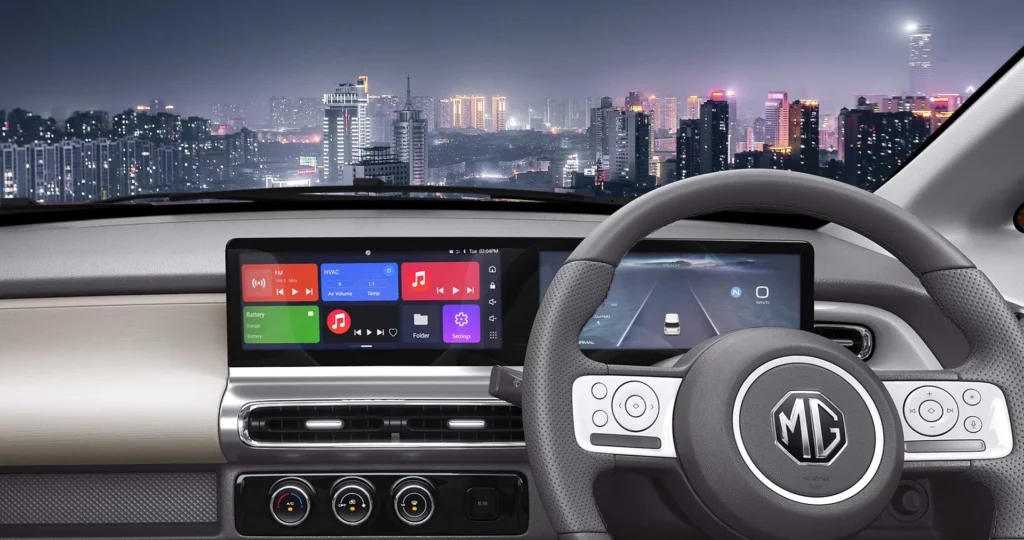
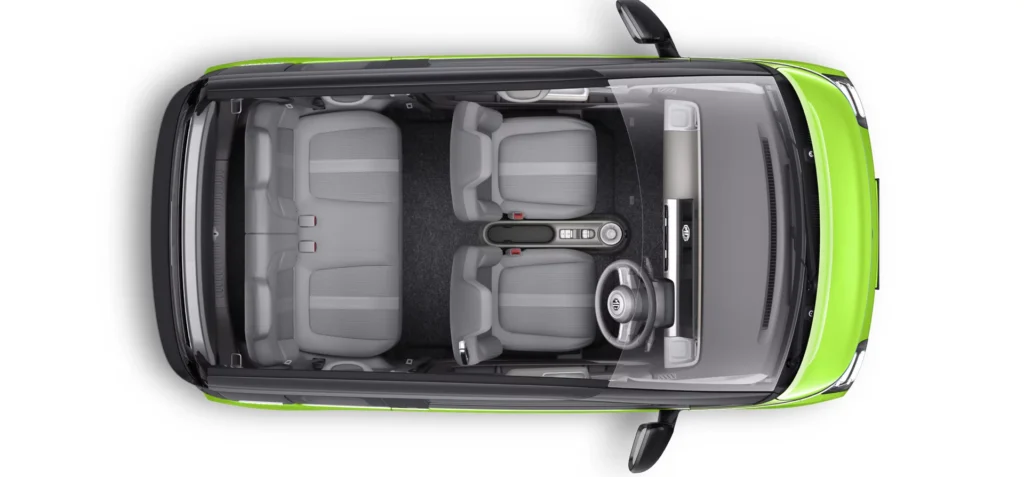
Performance and Specifications
Under the floor is a 17.3 kWh lithium-ion battery pack. A single electric motor (permanently excited synchronous type) drives the rear wheels. Peak output is modest – about 42 PS (roughly 41 bhp) of power and 110 Nm of torque. In real-world terms, that makes the Comet EV slow off the line (0–100 km/h takes nearly 20 seconds) and limits its top speed to around 100 km/h (MG electronically limits speed to around 85–100 km/h for efficiency). But because the car is so light (only about 815 kg with battery) and small, its power is adequate for urban use. It also helps that the MG has disc brakes on all four wheels (unusual for a car this small) and a taut suspension (MacPherson strut front, multi-link rear) for stable city handling.
The MG Comet EV’s ARAI-claimed range is 230 km on a full charge. In normal city driving this should be sufficient for daily use; in mixed conditions drivers report closer to 180–200 km of real range. Charging is slow by modern EV standards: the standard onboard charger is only 3.3 kW, so a full 0–100% charge takes around 7–8 hours (typical overnight home charging). Upper variants offer an optional 7.4 kW AC fast-charger, which can do about 10–80% in roughly 2.5 hours. (Note that the Comet EV has no DC fast-charging port – MG omits any high-voltage quick-charge inlet – so all charging is via AC wall-plugs.) The battery pack is IP67-rated for water and dust protection, and MG provides a generous 8-year or 120,000 km warranty on the battery. Overall, the Comet’s drivetrain is tuned for efficiency and city use rather than performance – its strength is quiet, smooth running and very low running costs (MG estimates around ₹500 per month on charging).
Key specifications of the MG Comet EV are summarized by the maker as follows: length 2974 mm, width 1505 mm, height 1640 mm, wheelbase 2010 mm, seating for 4. Motor power is 42 PS (31 kW), torque 110 Nm. Battery capacity 17.3 kWh. Range 230 km (claimed). Charging 3.3 kW AC (7–8 hr full), 7.4 kW AC fast (0–80% in ~2.5 hr). No DC charging. Disc brakes front (all four on Exclusive), EPS steering, turning radius 4.2 m.
Technology and Safety
Despite its size and low price, the Comet EV is well-equipped with tech and safety features – especially on higher trims. The dashboard’s twin 10.25″ screens are one highlight: the left panel is a digital instrument cluster, the right is a touchscreen running MG’s infotainment system. The system supports wireless Apple CarPlay and Android Auto, Bluetooth music and phone, and built-in navigation. MG’s i-SMART connectivity adds over 55 online features (real-time vehicle tracking, remote climate control, live car stats, over-the-air updates, etc.). The car also has modern conveniences like push-button start, a proximity key fob (with a digital key sharing function in top models), a rear-view camera (standard on higher variants), front and rear parking sensors, and a digital tire-pressure monitor. A “Valet mode” and custom screen themes are also offered.
Safety-wise, MG fitted dual front airbags and ABS with EBD as standard. All variants get front seatbelt pretensioners and 3-point belts all around, and high-strength steel in the body (17 hot-stamped panels) for crash protection. Higher variants add more kit: ISOFIX child-seat anchors, an electronic parking brake (with auto-hold), a reverse camera, and even electronic stability control with hill-hold. (Notably, MG claims the Comet has front and rear disc brakes for strong stopping power, though lower trims actually use rear drums.) The car also includes conveniences that enhance safety, like speed-sensitive auto door locks, follow-me-home headlights, and impact-sensing auto-unlock. MG says it built the Comet with safety in mind: “high on safety features like ABS + EBD, Hill Hold Control, Electronic Stability Control” among others. Overall it has far more equipment than an ultra-basic city car, especially in top trims, which now even get a four-speaker sound system and faux-leather upholstery.
Pricing and Variants
The MG Comet EV is priced from about ₹7.00 lakh to ₹9.81 lakh (ex-showroom, pan-India) in its 2025 lineup. There are five main variants: Executive (base), Excite, Excite FC (with AC fast-charger), Exclusive, and Exclusive FC. The top-spec model is the new Blackstorm Edition, which adds special black-and-red styling and costs about ₹9.81 Lakh ex-showroom. To keep prices low, MG also offers a Battery-as-a-Service (BaaS) option. With BaaS, buyers pay a lower upfront price (around ₹4.99–7.80 Lakh depending on variant) and then pay a small per-km battery rental fee (around ₹2.5/km). For example, the Executive trim costs about ₹7.00 Lakh with the battery purchased, or ₹4.99 Lakh plus ₹2.5/km on the battery plan. In practice this means an upfront saving of roughly 30–40% if one chooses battery rental, at the cost of monthly fees.
MG has made one modest price revision in 2025: a 1–1.5% hike took effect from July 2025, so the latest prices are as above. The Comet EV is notably cheaper than most other Indian EVs. For context, a Tata Tiago EV starts around ₹8–9 Lakh and a Citroen eC3 starts around ₹11–13 Lakh. With the Comet, even the base Executive is under ₹10 Lakh. MG has positioned it as its most affordable car ever (even its smallest petrol engine car is more expensive), aiming to tap the market of buyers who want an EV as a second/urban car or for short commutes.
Market Positioning and Competitors
The Comet EV is essentially a micro electric hatchback – one of the smallest four-seat electric cars on sale in India. MG calls it a personal “city runabout” designed specifically to ease urban congestion. In this sense it sits below larger city EVs like the Tata Tiago EV or Tigor EV (both with bigger 19.2–26 kWh batteries), and far below midsize electric SUVs. Compared to the only other similar-priced EV, Citroen’s eC3, the Comet is much smaller and lighter. Car comparisons show the Citroen eC3 has a 29.2 kWh battery and about 320 km range, whereas the MG Comet has only 17.3 kWh and ~230 km. Likewise, the Tata Tiago EV (19.2 kWh, ~223 km range) is larger, more powerful (60 bhp) and faster, but also costs roughly ₹2–3 Lakh more. The Comet’s advantage is its low cost, tiny size, and chic style. It competes more with premium electric scooters and auto-rickshaws in spirit, providing a clean, all-weather alternative that can carry four people.
In the 2025 EV market, the Comet fills the niche for “ultra-compact city EV”. Its direct competition is limited: Mahindra’s old eKUV100 was similar in concept (tiny 2-door EV), but that model was discontinued. Maruti Suzuki has announced a small electric hatch (the eVX concept) for 2026, but nothing direct for now. On one hand, the Comet is roughly in the price range of high-end electric two-wheelers or retro Mini electric cars like the eJeeps/Lozads, but it offers more space and safety. In media polls and reviews, many buyers cite its easy parking and fun design as positives. However, its low speed (road-limited to ~85–100 km/h) means it’s not suitable for highways; MG itself markets it firmly as an “urban mobility solution”.
Autocar India notes that the Comet is “compact and comfy” and a way to reduce one’s carbon footprint, calling it “fresh, bold, attractive and non-conventional”. Experts point out that at its price point, no other car offers this combination of features and size. In effect, the Comet EV creates its own category: more than a high-end scooter, less than a full-sized hatchback. As one review puts it, it “won’t make you miss your bigger car” for city drives.
Also read | MG Hector Best SUV Under ₹25 Lakh in India in 2025 : Price, Variants & Features
Also read | MG Windsor EV Car: Price, Features and Specification
Conclusion
In summary, the MG Comet EV Car is a very compact, city-focused electric car introduced in India in 2025. It packs a 17.3 kWh battery and a 42 PS rear motor into a tiny 2.97 m body, giving about 230 km of claimed range. Its chief attractions are the low price (under ₹10 lakh ex-showroom), premium styling and features (twin 10.25″ screens, connected-car tech), and ease of parking. Safety equipment and build quality are surprisingly good for the segment. On the downside, performance is modest (slow acceleration and limited top speed) and charging is slow (no fast DC charging). But for urban commuters wanting a compact EV, the Comet delivers an eye-catching package. As MG continues to support it (with new editions like the Blackstorm trim) and more charging infrastructure comes online, the Comet could appeal to many city drivers and families needing a small electric car.